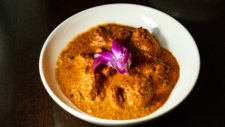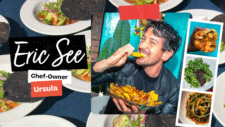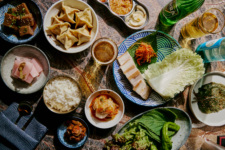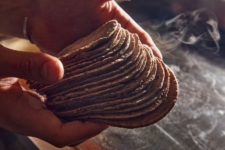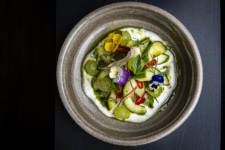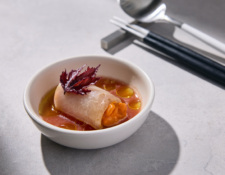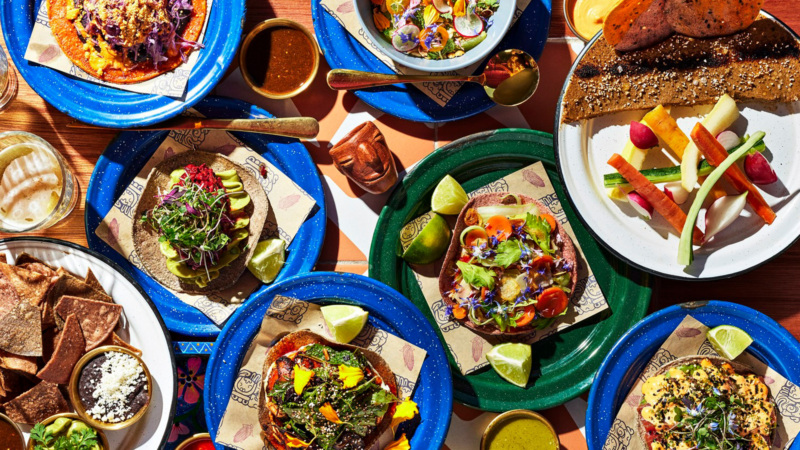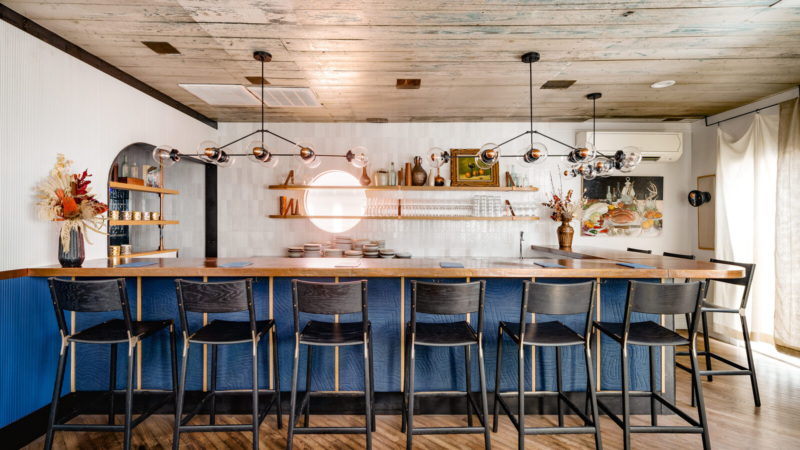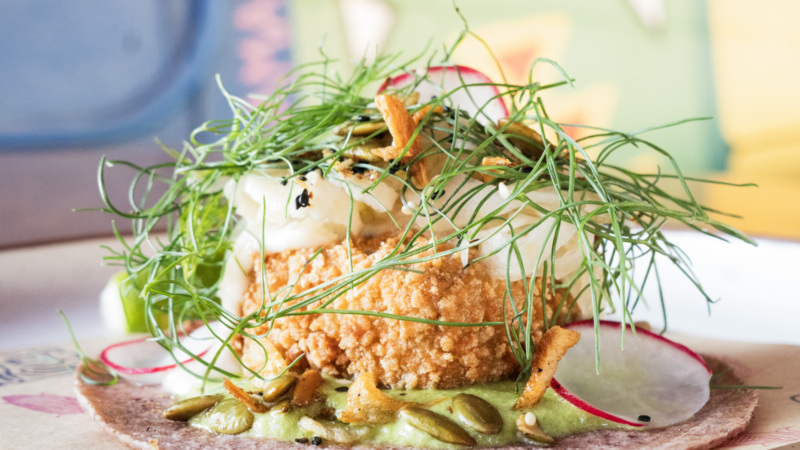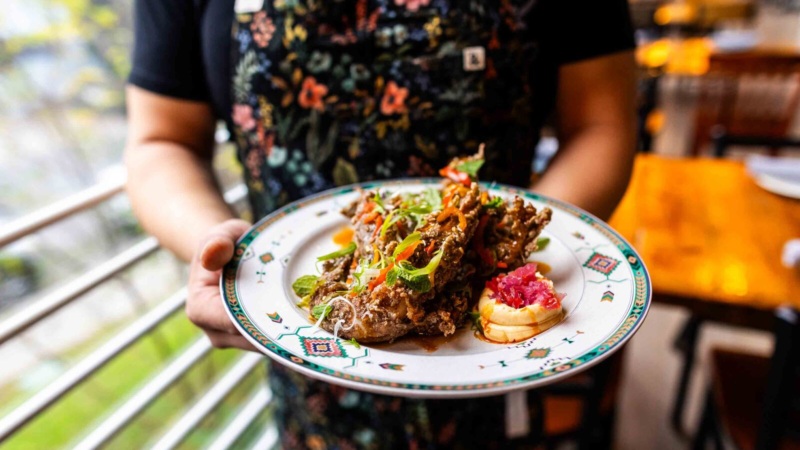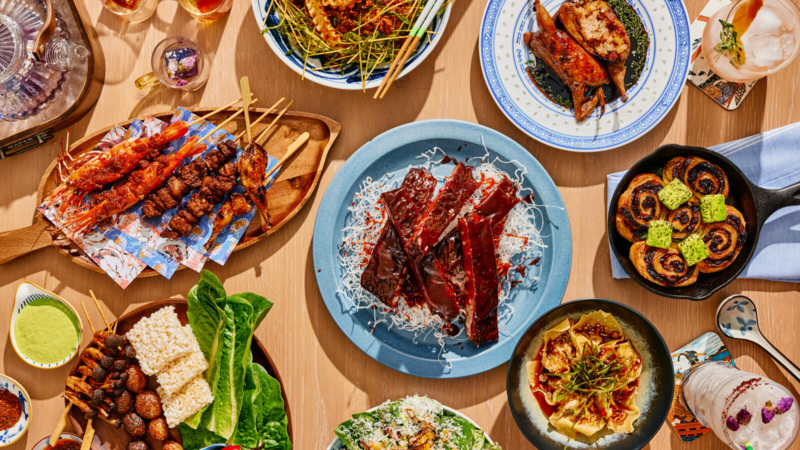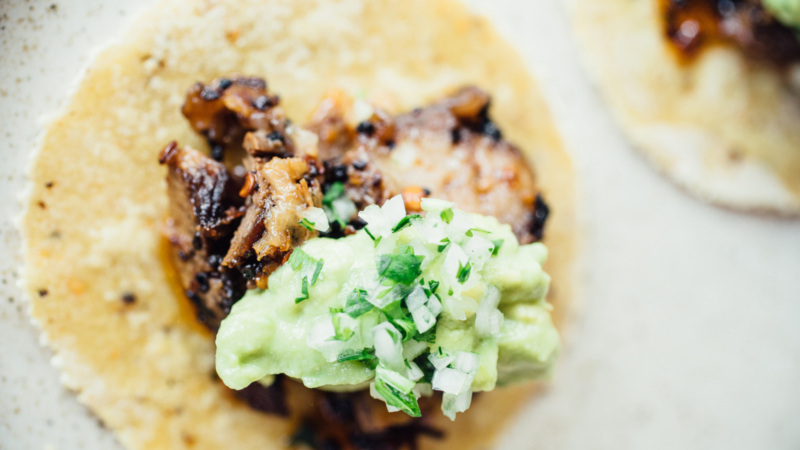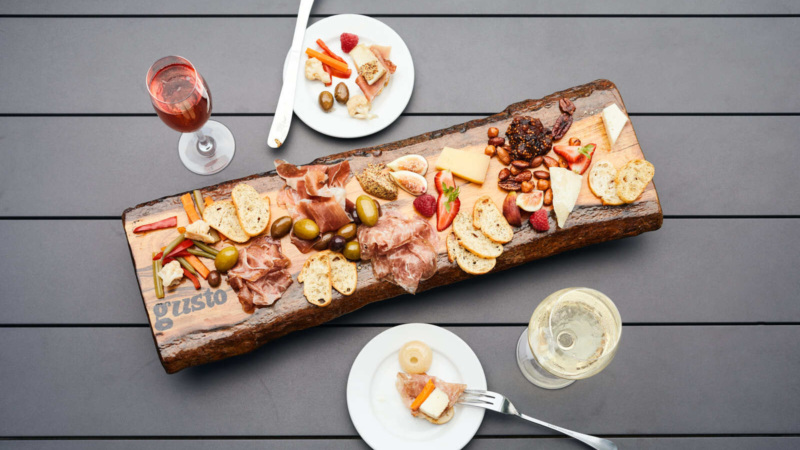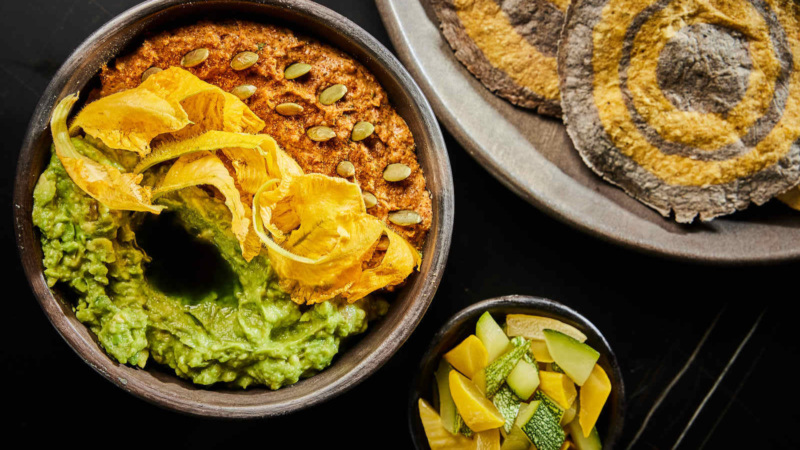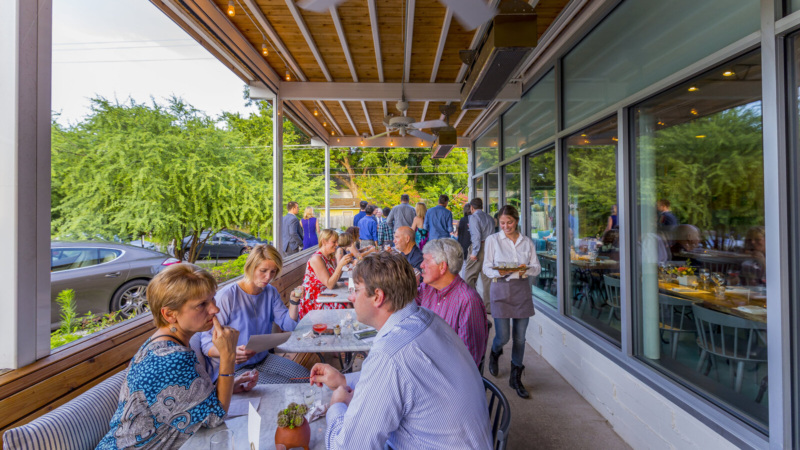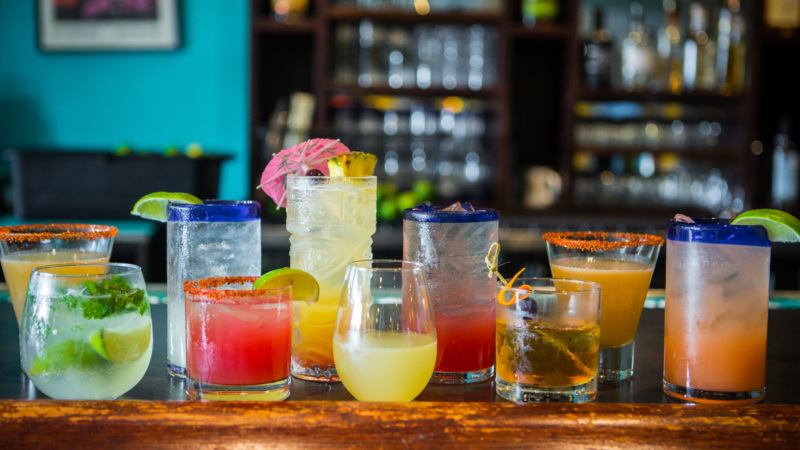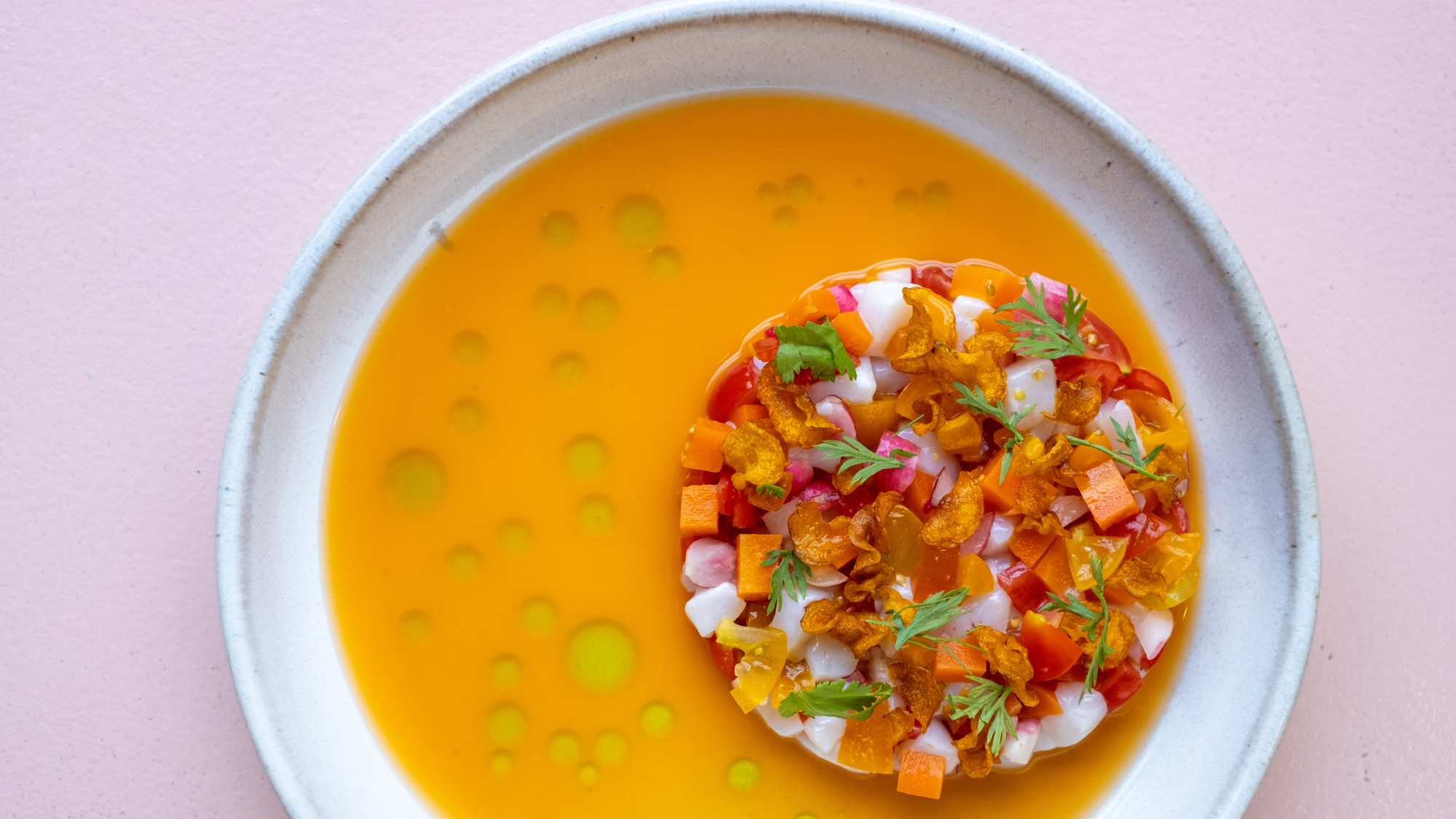
Never Mind ‘Authentic.’ Fermin Núñez Is Defining the Mexican Food of Today
We love learning what makes great chefs and restaurateurs tick. So we’re pleased to introduce The Access Interview, a longform series that allows these tastemakers to discuss their work in depth. You can also discover their work yourself, as many of their restaurants offer exclusive access to qualified American Express cardmembers via Global Dining Access by Resy.
On a spring evening at Fermín Nuñéz’s Este, the murmurs and clinking of margarita glasses blend with breezes on a patio encased by the shade of pecan trees. Even if no one is saying “life is good” out loud, that’s surely the general vibe among early diners as they tuck into oysters. So begins one of those nights of al fresco gourmandizing that Austin does so uniquely well.
Certainly life has been good for Nuñéz lately. Sporting a baseball cap instead of his usual bandana headband and a stiff white chef’s coat embroidered with his title, “El Chef,” Nuñéz is fresh off the high of a pre-shift family meal, but also the recent recognition for both Este and its sister restaurant Suerte, on the The New York Times’ 25 Best Restaurants in Austin.
This recognition is not new, though. When Suerte, Núñez’s first restaurant with Sam Hellman-Mass opened in 2018, it catalyzed a new style of Mexican American cooking. Specifically, it was a harbinger of the masa movement, wherein nixtamalized corn is the starting point for tortillas, molotes, tlyaduas, and other Latin American specialties. Soon after opening, Food & Wine hailed Suerte’s “altar to all things masa.” Today, nixtamalization has become a standard for any serious Mexican restaurant in America.
At Núñez and Hellman-Mass’s second restaurant, Este, situated next to a chef’s garden and their tapas spot Bar Toti, the status quo is being challenged again — a seafood joint several hundred miles from the shore? The absence of a nearby coastline aside, it maintians ties to Texas in a way other modern Mexican restaurants do not. For instance, Don Artemio in Fort Worth and Tatemó in Houston bypass locally grown corn to import from Mexico. Núñez, on the other hand, sources Texas corn from Barton Springs Mill in nearby Dripping Springs. His reason for doing so comes easy when asked: “Because we’re in Texas.”
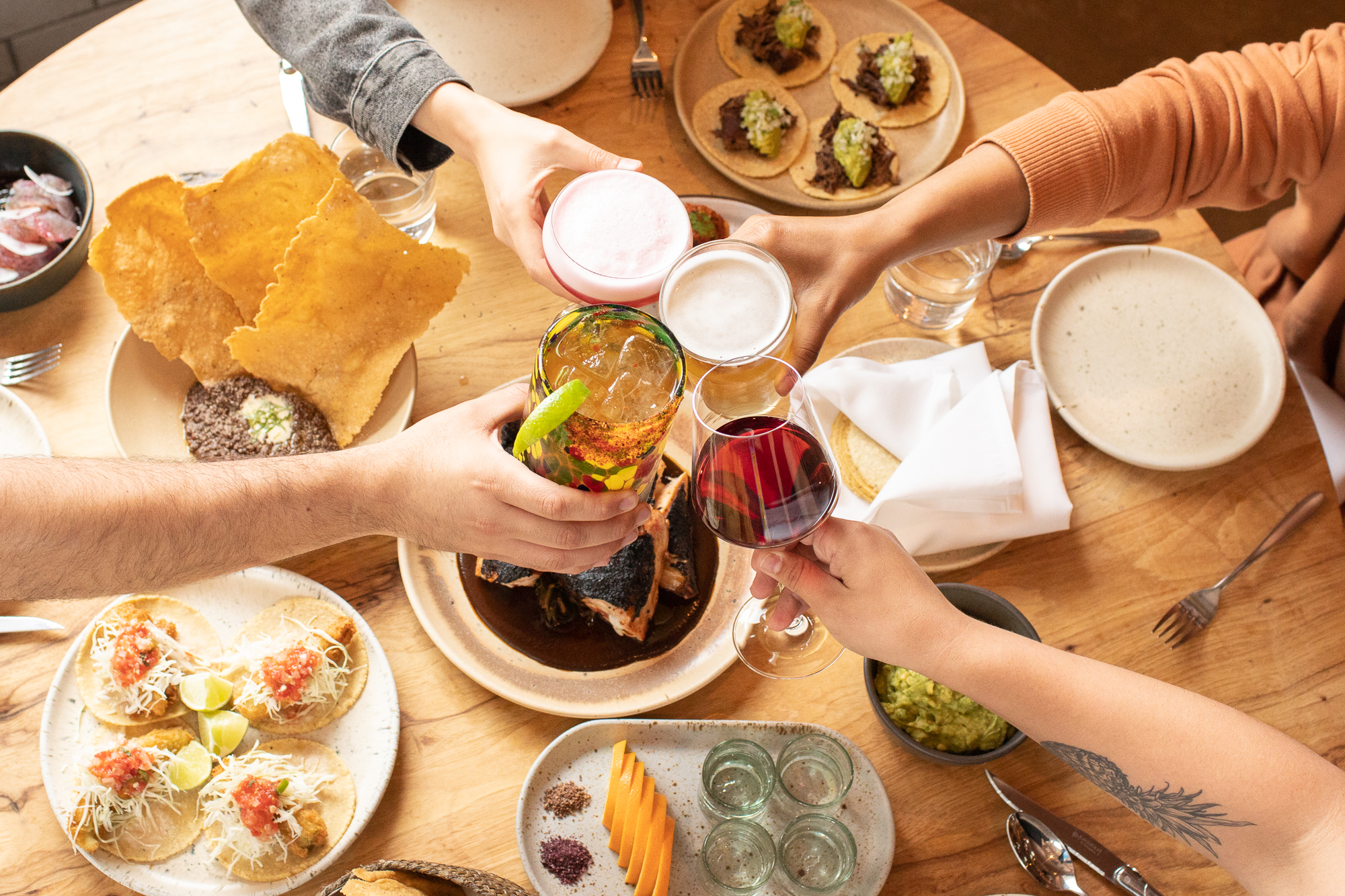
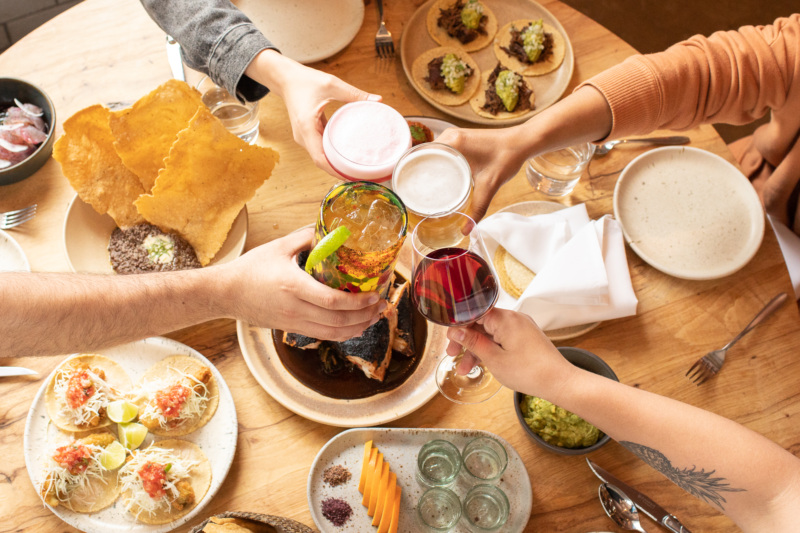
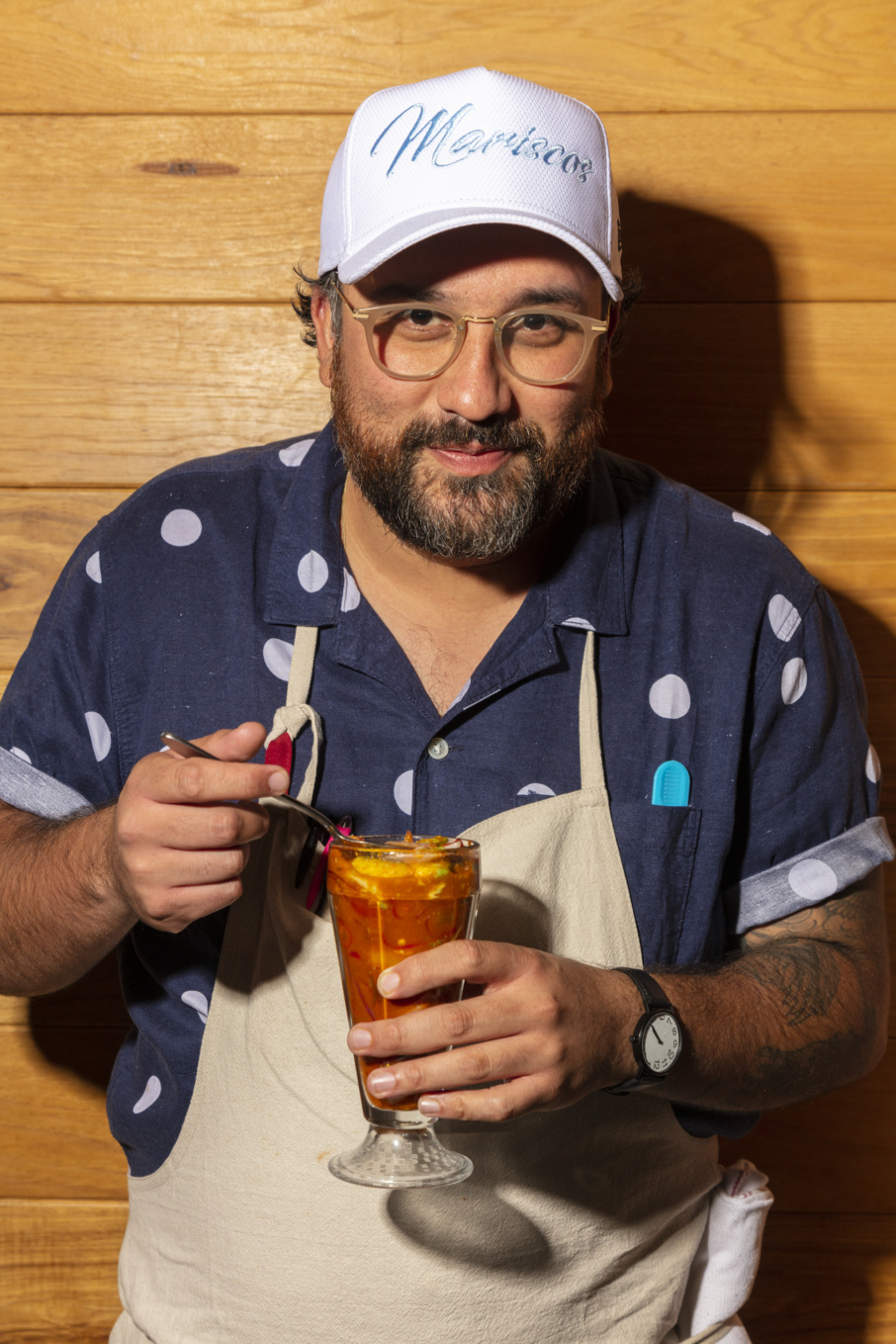
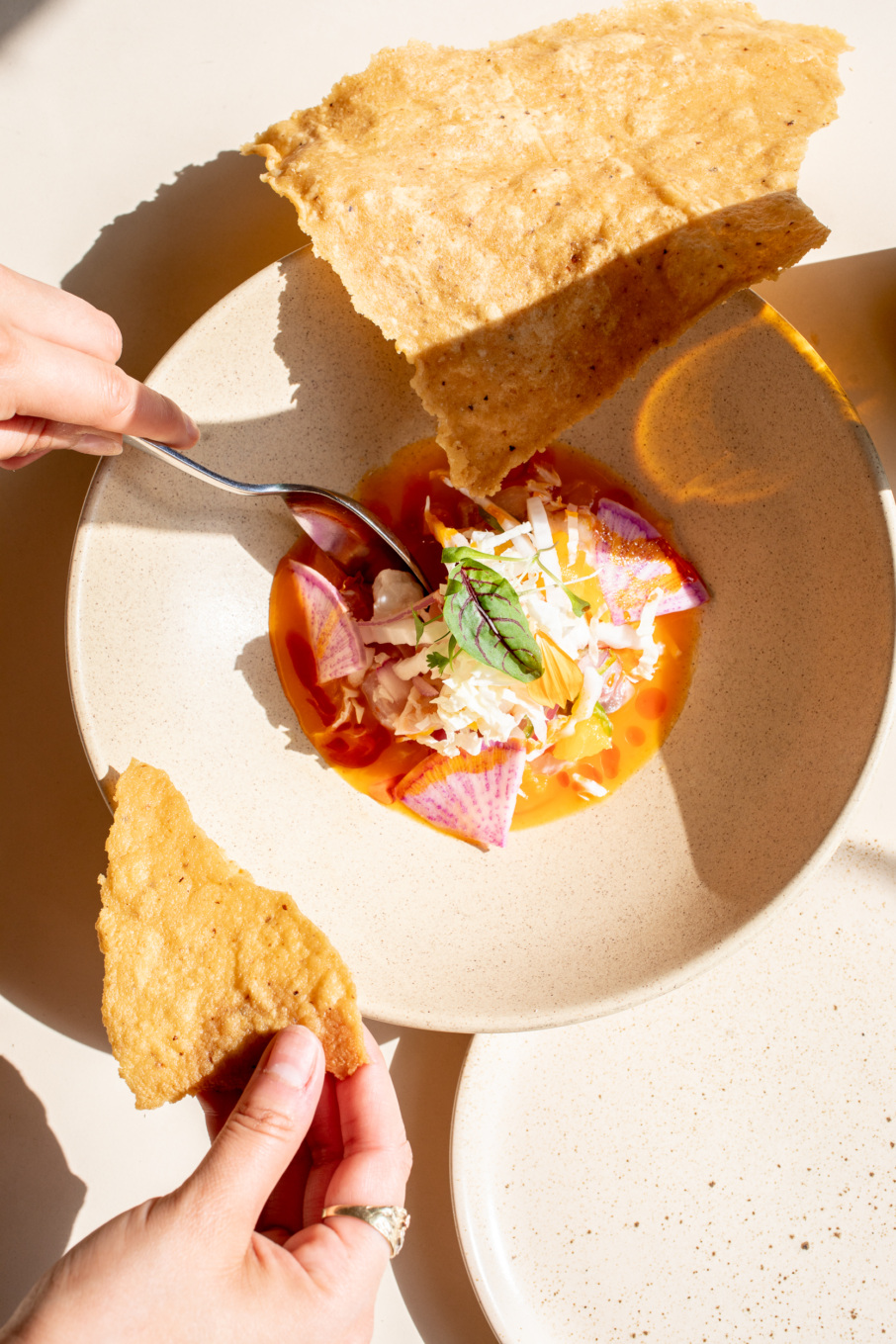
So while Núñez’s cooking is rooted to Mexico by way of technique (he was born in Torreón, Coahuila), he is clear he is not attempting to present regional Mexican cuisine in perfect fidelity. “When you end up copying something, it’s not genuine. And I think people can taste that,” he says. He rather prefers to take inspiration from what’s already around him. For example, he recently adapted celtuce, a Chinese stem lettuce that grows in Austin, to incorporate into a fire-roasted salsa. “I’m constantly getting inspired from a lot of different things,” he says.
Núñez is now marching on from his nixtamalization mission — and even past what once were accurate descriptions of his cooking, like “Mex-Tex.” Like tastes in music, his view of Mexican cooking is one that shifts with time, he says. At Este, the goal is to prove Texas’s landlocked capital can serve some of the nation’s most innovative seafood — and that the praise for Suerte wasn’t just beginner’s luck.
We recently spent time with Núñez, trying to better understand how he defines his style, how it fits within the larger Mexican American canon, and where he’s going next.
This interview was edited for length and clarity.
RESY: So how did you originally get into cooking?
Fermín Núñez: I grew up in northern Mexico and Texas, kind of back and forth. When it was time to go to college, I didn’t know what I wanted to do. So I went to University of Texas at San Antonio for one year.
At some point that year, I ended up reading “Kitchen Confidential” by Anthony Bourdain, and I fell in love with the lifestyle — that pirate way of living. So I went on a tour of the Arts Institute of Houston [which had a culinary program before closing in 2023], and decided that’s what I wanted to do.
I got my first official kitchen job at the Houston Country Club. It was owned by Fritz Gitschner, an Austrian chef. He was a certified master chef. At the time, there were only about 40 or 50 in the United States, and that was the kind of cooking I was pursuing.
What kind of food did you make there? Like, typical country club food?
It was a lot of French techniques and traditional cooking methods that people were looking to at the time, which was very European-leaning. You know, all the sauces.
Clearly that’s not quite the way you cook today.
The way I cook starts with what I’ve learned to enjoy throughout my career. A lot of that has been — more than adding to the repertoire of what I like — editing what I don’t like that much anymore. Back when I started cooking, and this is the case for a lot of chefs, you want to see how many things you can put on a plate. You want to showcase all your techniques because you feel like there’s value in including six different components that express different techniques. Now, I enjoy things that are a little bit simpler but done well. However, I had to go through that — doing all those extra things — to be able to define what I don’t want to be.
The way I describe what we do at both restaurants is we’re rooted by Mexican cooking techniques. It includes going against some of the things I learned as a chef, but also with an understanding of what good cooking is. It doesn’t necessarily translate into cooking something the right way, at the right doneness. It goes into sourcing, too.
So for example, we nixtamalize corn that is grown here in Texas because it’s the best corn that we can get here. We make tortillas you wouldn’t necessarily find in Mexico — but they will remind you of the best ones you’ve had in Mexico.
It’s been six years since Suerte opened, and it feels like the whole masa movement has finally taken off. Where were you in the timeline of that movement?
It definitely felt like we were early to the game, yeah. Seven or eight years ago, when we were in the process of sharing what Suerte was going to be, I had to explain a lot about nixtamalization, and why we were so keen on having all the tortillas pressed to order, one at a time, and never reheating them.
Now it’s not a big part of the conversation. Nixtamalization is now an expectation of a great Mexican restaurant. When you go to a high-quality Italian restaurant, it is expected that they’re making their own pasta, maybe milling their own grains. And I feel like Mexican food is finally having that moment.
I want to go back to this idea of Texas ingredients with Mexican techniques. You’re using charcoal at Este, whereas here in Texas, wood-fired cooking is more of a thing. Why?
We use charcoal at Este specifically because that heat is more conducive to cooking fish. You want to treat the fish as simply as possible. For the fish that we grill, we want a little bit of that char, but not necessarily a lot of smoke.
When we were asking ourselves if we wanted to cook with wood or charcoal at Este, I noticed that when I closed my eyes, 100 percent of the time, when I think of somebody grilling by the beach, it’s always charcoal.
It’s different at Suerte, where we have a smoker and a grill that uses wood. We’re in Texas, and we want to implement those smoky flavors for goat, chicken, steak, pork — all of those things that can take more time on the grill.
Nixtamalization is now an expectation of a great Mexican restaurant. When you go to a high-quality Italian restaurant, it is expected that they’re making their own pasta, maybe milling their own grains. And I feel like Mexican food is finally having that moment.— Fermín Núñez
I want to ask about the seafood. Some have seemed surprised that Austin, of all places, has a good seafood restaurant. Do you ever feel like this shouldn’t be such a shocking fact?
For me, it’s not a shock because I’ve been in Austin for 15 years now. Places like Uchi have opened the door. It was once shocking for Austin to have a great sushi restaurant from Tyson Cole, a chef who is not Japanese, sourcing fish from high-quality places. I can see how it once was a little bit weird or different. But also, we have technology. It’s 2024. Why are we so amazed that we can get fish in a place like Austin, when you can order something on your phone to have at your front door in six hours?
What about the sourcing of the fish sold here at Este? Are you using wild-caught or farm-raised?
We use a combination. I think there’s a misconception of what farm-raised can mean. When you source a tomato, there are high-quality tomatoes that can be grown in greenhouses, and also out in the field. It’s about understanding the scenario where the fish comes from. If we’re going to go the farm-raised route, we’re going with what we’d be happy to serve our loved ones.
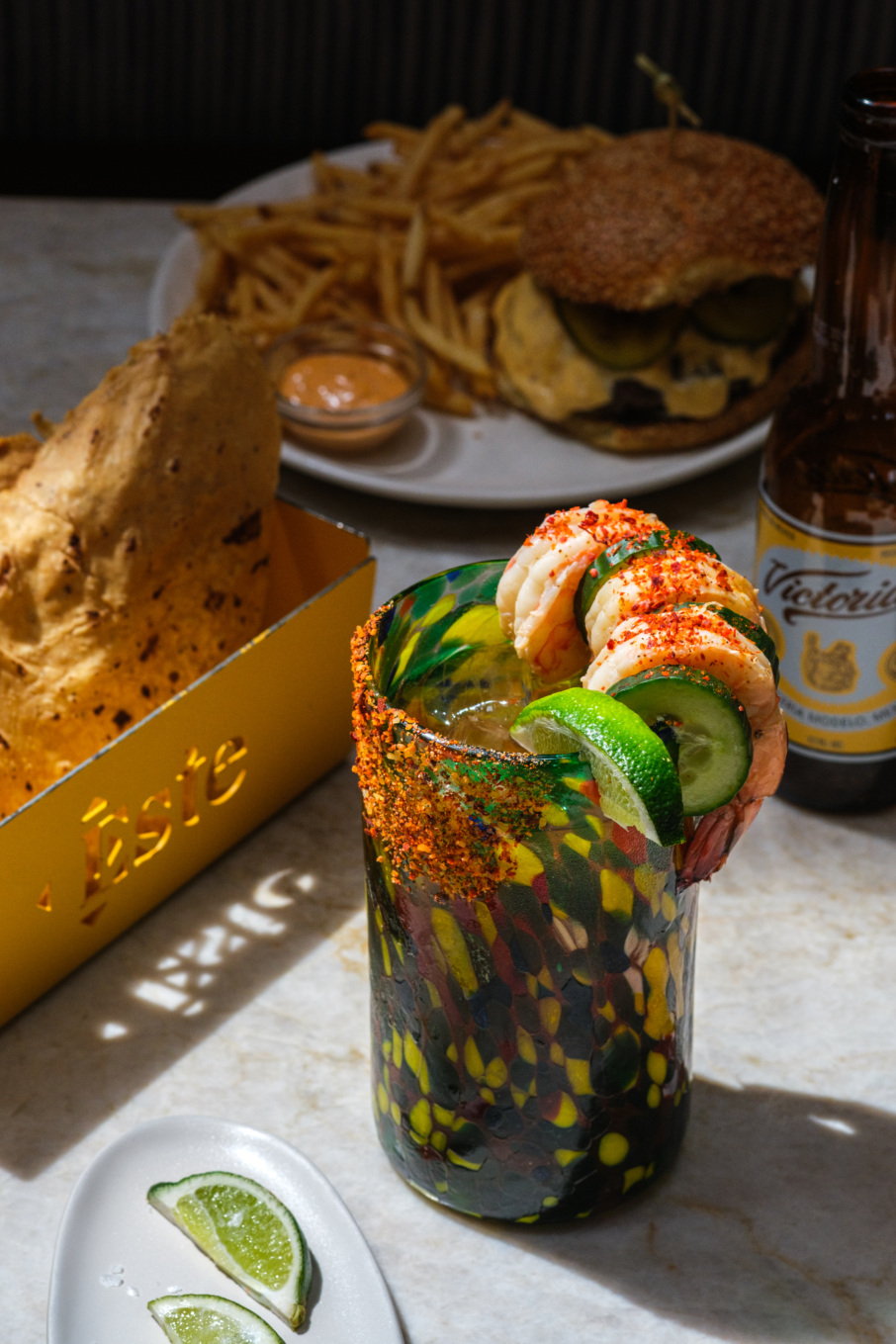

Does your birthplace of Torreón show up on any of your menus? And where do you pull from other regions?
I’m from Coahuila, which is a state in northern Mexico where it’s a desert. Not a lot of stuff grows there. There are a lot of industrial farms and technology companies — a huge LG plant and a Tyson chicken plant. So there’s not a lot of inspiration I can get from there.
But I ate a lot of different staples from other states — like, maybe not the best representation of carnitas, but better than the ones I had had at that point. I love that I was born in Mexico, but Coahuila isn’t a region that is recognized for its cooking. Every now and then, there are things that I’m excited to put on the menu, like a salsa that I remember eating at my friend’s house, or a salsa that we used to make because we were trying to recreate the carnitas that we used to eat on Sundays.
It’s understanding the flavors and the palette, and recreating them in a way that’s not copying, but inspires memories of the best suadero tacos you had in Mexico City. Rather than recreate the taco, I want to recreate the moment.
Is there a region you pull from more than others?
For the first year or so when we opened Suerte, we were described by other people — not us — as being Oaxacan-inspired. It wasn’t necessarily inaccurate, but it wasn’t something I would say.
I feel like I go through phases, similar to how everybody goes through music phases, where you listen to an album and then learn about another album. You like one song, and then you discover another one. I like to describe my cooking in that way.
I cook based on what I’m excited about in a moment, and sometimes it’s from travels to another part of Mexico that I haven’t been in a minute. Sometimes it’s an ingredient that is growing here that is not necessarily used in Mexican cooking, but it can be applied. What I do isn’t tied to one specific place, but I think the common denominator is — it has to taste of what, to me, is now Suerte and Este. Does it taste like it’s simple, but it has a little bit of heat? It has to have a little bit of a masa flavor. At Suerte, you taste a little bit of smoke. At Este, you might get a taste of acid. Can you eat it with a tostada? Can you put a little bit of salsa on it? All of those things that Mexican food is. It’s more than just following traditional recipes. Food is the thing that happens on the table.
Rather than recreate the taco, I want to recreate the moment.— Fermin Nuñéz
Nice. How does it feel to be seen as someone who has fathered a new genre of Mexican American cooking?
It’s very flattering. That’s an honor. I see my way of cooking as unique to me because I was lucky enough to be born in Mexico, so I don’t have to try too hard to make anything Mexican just by virtue of my green passport.
I grew up in northern Mexico and Texas, back and forth, all my life. When I was a Mexican kid here in the states trying to be American, I wasn’t American enough. And when I was the American kid in Mexico, I wasn’t Mexican enough. I’ve always been on this line of: Am I an American? Am I Mexican? I feel very Mexican, but that doesn’t mean that I’m not American, right?
I always describe Suerte as: Its first language is English, but it’s very fluent in Spanish. That’s how I would describe my cooking. It’s unique to this new generation of chefs. We are not afraid to speak up and say who we are on a plate. By making salsa with fennel, by making a dish with celtuce that tastes Mexican, by making a quesadilla with beautiful cheese from France, but pairing it with local greens, like you would find in Mexico. It’s a little bit of that. Like, how can I pair a Comté that has been aged for 18 months with beautiful quelites that were grown here at Este? Or maybe I pick some nopales outside of my house, because it’s the perfect time of the year when they’re soft, and I make a salsa with them.
I’ve also been cooking professionally for 18 years now, and only the last six years have I been cooking Mexican. I’ve learned how to cook everything else but Mexican food.
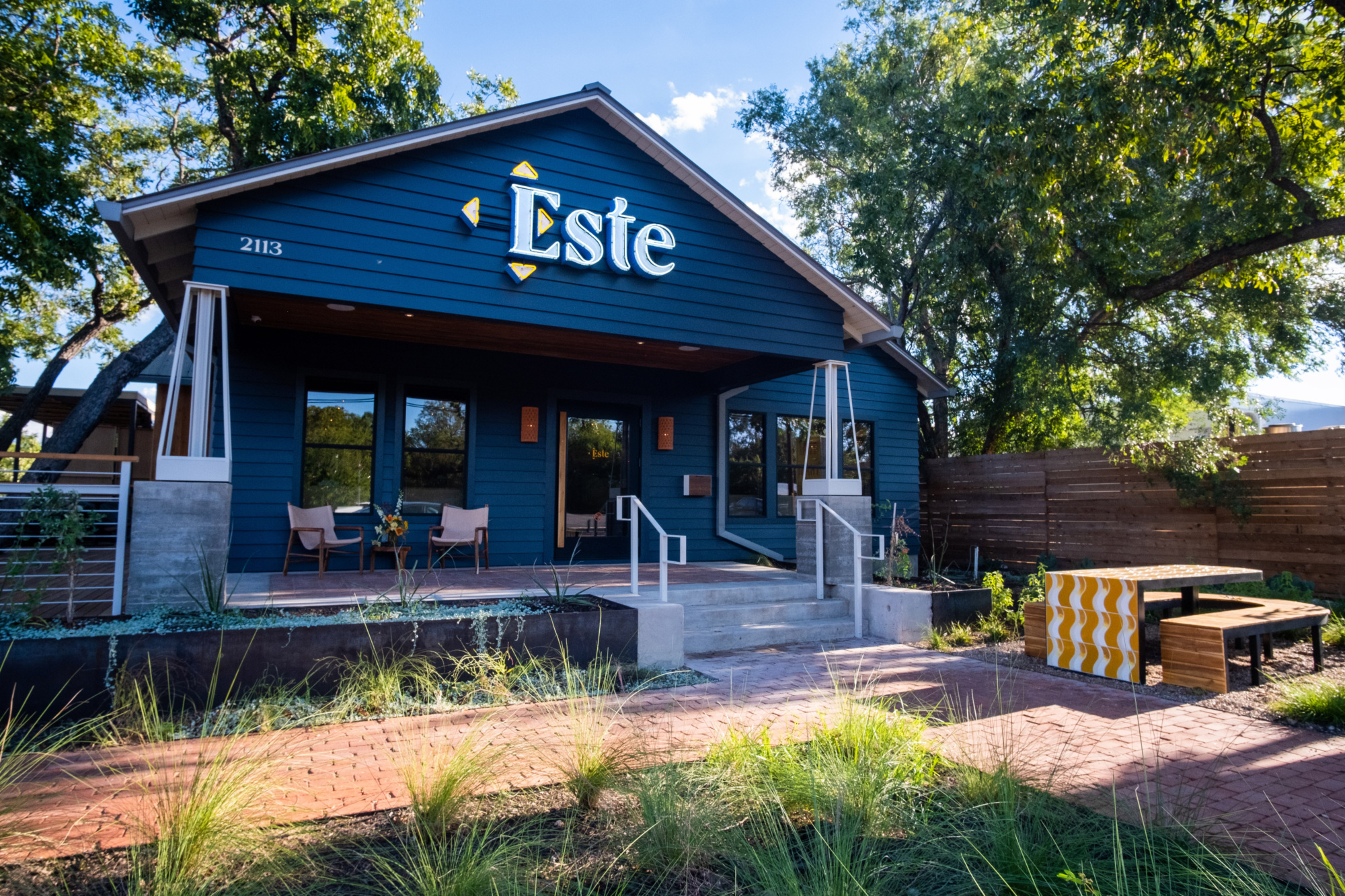
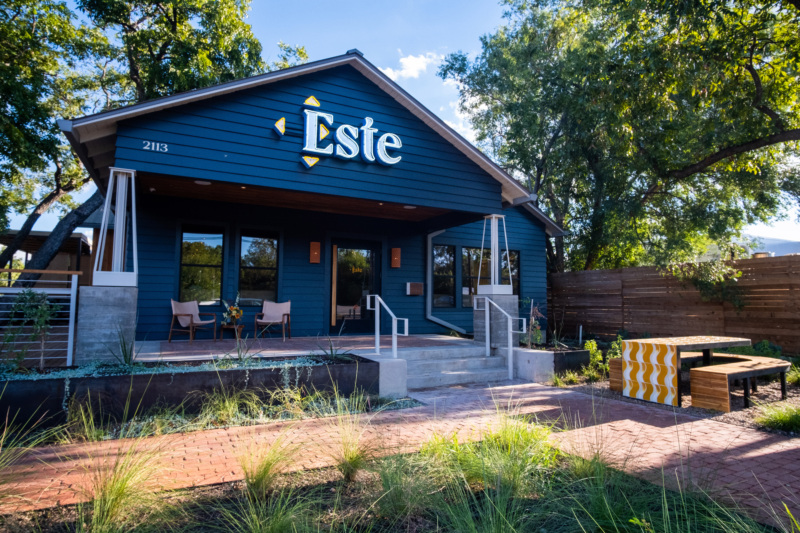
So is there a name for this style of cooking? Like, you use Texas corn, but it’s not Tex-Mex.
Tex-Mex is not what I imagine when I describe my food. Years ago, Jordana Rothman at Food & Wine called it Mex-Tex. It’s a little bit of that, but if I were to go deeper and put it in a sentence, it would be utilizing both local ingredients and high-quality products and applying Mexican cooking techniques to them. That, to me, is the beauty of it.
To me, authentic Mexican cooking means going against the grain — kind of like mole, where you have twenty or thirty different ingredients, and you treat each of them in a specific way. You toast them, grind them, and marinate them, and then you turn it into a paste that cooks for hours. And then you add chocolate at the end, because if not, the sugar will go to the bottom, and it will become bitter. It’s like that.
Mexicans are very good at being resourceful with what we have, and it’s what makes Mexicans great at being Mexican. It’s not following a recipe.
But you surely picked up French techniques from culinary school and your time at the Houston Country Club?
That’s the background of any chef who hasn’t only been cooking Mexican food. I think that’s the exciting part. I use both French and Japanese techniques that I’ve learned throughout my career.
For example, one of my favorite dishes here is the ceviche. It’s inspired by the traditional style you’d find in Sinaloa, ceviche de sierra, made with mackerel. Traditionally, it’s cured and flaked mackerel, combined with carrot pico de gallo. It’s not pleasant to the eye, but it’s one of my favorite things. However, on Manor Road in East Austin, I can’t serve a mackerel that costs $50 a pound and, for lack of a better term, looks like cat food. But I love that dish, so I make the carrot pico de gallo on the side, and we pair it with barramundi, rockfish, snapper — fish you can eat in big chunks.
When I show people where that dish came from, it’s an aha moment. Like, oh, I get where that came from, and this is your version. The background of a good chef is taking something like high-quality fish, making a dish a little bit nicer, but not so refined to where it’s unrecognizable.
Would you say French techniques have improved your cooking?
I think both the French and Japanese have done some things extremely well. I will always roast a chicken the French way instead of the Mexican way. The French way usually leads to a chicken that is beautifully cooked with crispy skin, a moist breast, a juicy leg and thigh. Versus, if you roast a chicken the Mexican way, it’s probably going to be a little overcooked. It’s probably not going to be brined, and it’s not going to be as delicious. So I’ll stick with the French when it comes to roasting, but I’ll marry it with the mole sauce that I’m going to pour over it.
Can you give an example of a Mexican technique, then?
Burning things. It’s a combination of bitterness, burning, and char. Those are three different things that you can use to your advantage.
Going back to the beautiful thing about being resourceful, I don’t know any other culture that can take the same ingredient and turn it into three different things. Take a jalapeño, it’s just a chile. But dry it, it has a different name and application. Smoke it, and then put it in an adobo marinade, and it’s a completely different thing. I’m always looking for those things in the kitchen.
What are you burning at Este and Suerte?
We make an aguachile negro. We take shrimp, cut it in half, and marinate it in lime juice. Then we take our aguachile negro paste, which is a lot of onions, habañeros, and green onions, all charred until they’re black. Then we blend it with a little bit of burnt cacao to add a sweetish, bitter note and nuttiness. At Suerte, we are burning all the chiles for our mole. We take dried chiles that are a little dark but soft, and we turn them into ash. We also have a burnt habañero oil that we garnish one of our skate wing dishes with.
I always want people to savor everything while they’re eating, and then when they’re done, wonder why it tastes so good.
Mexicans are very good at being resourceful with what we have, and it’s what makes Mexicans great at being Mexican. It’s not following a recipe.— Fermin Nuñéz
So what’s next? Is there another boundary that needs to be pushed in regards to Mexican cooking in America?
The biggest thing I’m focusing on is getting Este to the place where Suerte is. When we opened Suerte, we had so many new people come in, and we had to do the spiel: this is a tlacoyo; this is a quesadilla; this is a tlayuda. Now, people trust us.
At Este, we’re still in that process. Mexican seafood is a little bit more challenging to understand because it goes against the grain. Sometimes we have flautas that have fish and cheese. If you’ve never had that, you’re probably going to be thrown off, but it turns out to be delicious.
I want to keep pushing mariscos culture. The reason we wanted to have Este is because every time we went to Mexico, we always went to the seafood restaurants. And always at these restaurants, we would end up staying an hour or two longer than we were planning because we were having such a good time. It’s a big part of Mexican culture, and it’s something I want to see more here in Austin, people embracing their weekends. We opened for Friday lunch because we want to be that place where you come thinking you’re going to go back to work, and you just don’t.
To me, mariscos lifestyle is enjoying the day, having a michelada, some shrimp, some ceviche, maybe having some oysters after that. It’s that sobremesa —it’s a leisurely thing, like, we’re here to have a good time, and we’re not rushing to get out of here.
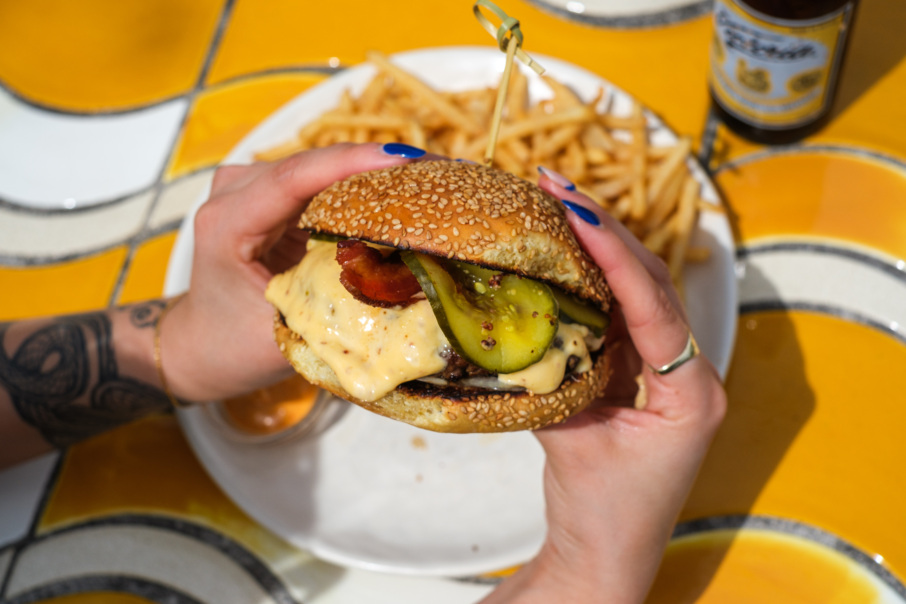
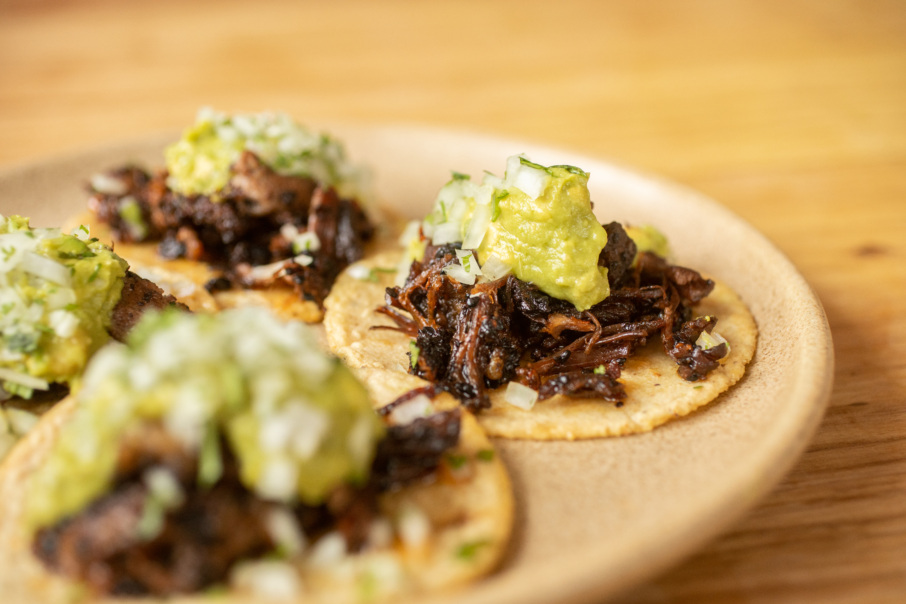
I noticed you also have a burger on Este’s lunch menu and at Bar Toti. Does a burger belong on all menus?
We want this place to be busy. We understand not everybody’s going to want the seafood experience. If you’re the friend who got dragged here by someone who wanted to come to this crazy seafood restaurant, we want to make sure you don’t hate us.
Burgers are one of the things that everybody recognizes, and I wanted to make one that was exciting. When I think of a lot of great American seafood restaurants, almost all of them have a great burger. Also, we’re in Austin, Texas, USA. So we don’t have to have a burger, but I think it’s fitting. At Este, it makes sense because it’s for lunch. We serve it with fries and grill the patty over charcoal, which is unique in the world of smash burgers. It’s hefty, cooked medium, with cheddar cheese, Hollandaise, bacon, and house-baked buns. It’s not trying to be a Mexican burger. It’s trying to be a great burger that you can get at a seafood restaurant.
You’ve won so many accolades, but do you feel like you’ve achieved what you wanted when you decided to become a chef?
In a way, yes. But also, I didn’t look at everything the same way I did back then. I have the chance to have the microphone now, and I always want to be conscious about that. I want to be the voice I wish I would’ve heard five or ten years ago.
But I’m not done. I want to explore more. It feels like I can actually get started now because I can make an impact.
What would you say to the next generation of chefs?
When I started cooking, I was trying to impress others based on their expectations of me. Now, I want to always encourage people to pursue what makes them happy. Put in the work to get to your goals and shine at whatever you want to do. It doesn’t have to be Mexican food. It can be whatever food you grew up with, whatever you’re passionate about, whatever culture you want to represent — even if it’s not your own. Pursue it, and don’t skip the steps to get there.
Is going to culinary school one of the steps?
I think this is something worth talking about. Unlike many other careers, culinary school is not something that you need to be successful. If you’re going to be a doctor, lawyer, or architect, you have to go to school. But to be a successful chef, you don’t have to go to school. If you do, make the most out of it and truly engage. If you’re going to spend that money, get your money back. Pay attention. Go to the classes.
When we were opening Este, I happened to be checking messages from unknown senders, which I never do. And there was this kid, who was like, “Hey chef, I’m in high school. I am thinking about going to culinary school, but I’m asking a few different chefs if they think it’s worth it.”
I told him to come to the restaurant and I’d talk to him for 15 to 30 minutes and explain. He showed up with his dad, and I told him, if debt is a consideration, work for six months in a kitchen first to see if it’s really what you want to do.
After he graduated high school, he messaged me again and asked for a job. He started at the ceviche and salad station, and now he’s running the grill. This is how I see my role nowadays.






